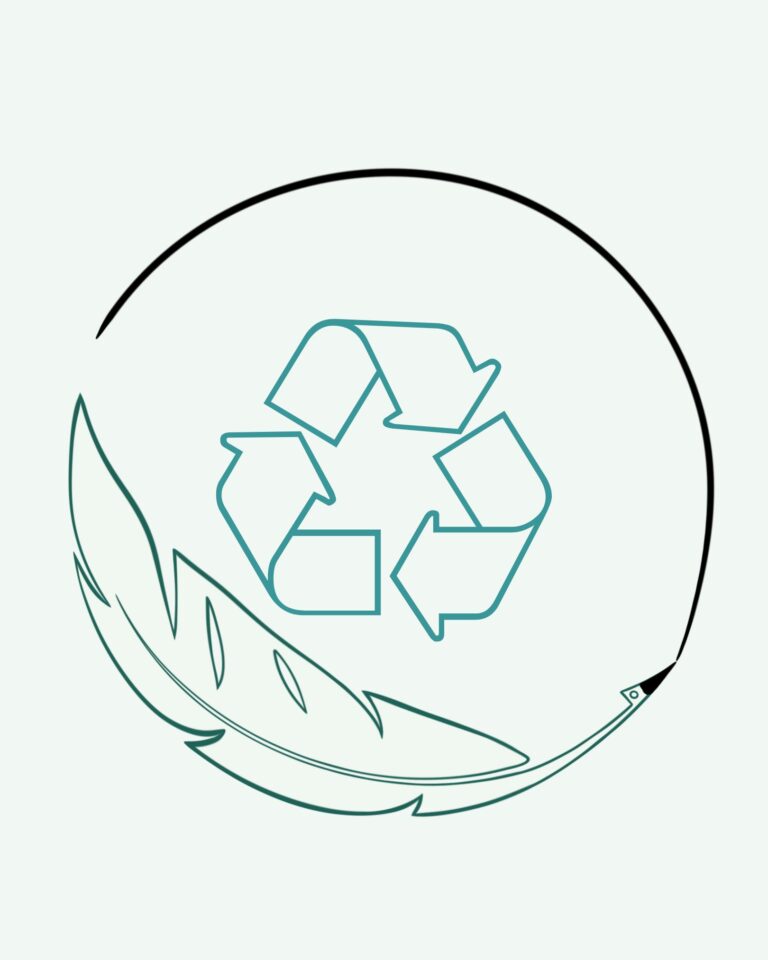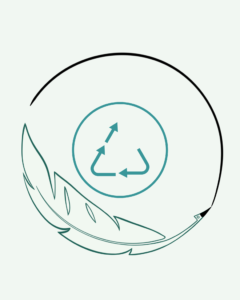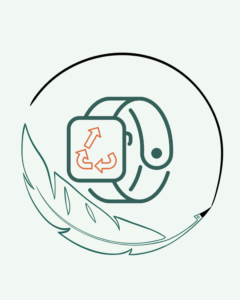What is Recycling?
Recycling is the process of reprocessing used or waste products and producing new products from them. Although recycling processes are mostly industrial processes, they are based on a collective solution, that is, a collective transformation, specific to the determined wastes. These processes can contribute to preventing waste from harming the environment and using natural resources more efficiently.
Recycling is generally applied to paper, plastic, glass, metal and organic waste, metal and glass can be recycled infinite times. These wastes can be recycled for reuse by going through certain processes or by separating them appropriately. For example, paper waste can be recycled and used again as raw material for paper products, plastics can be reprocessed and used in the production of new plastic products, glass waste can be melted to make new glass products, metal waste can be melted and reused or turned into different metal products, organic waste can be used as compost or biogas production.
The Main Purpose of Recycling
The main purpose of recycling is to reduce the harm of waste to nature and prevent the depletion of natural resources. Additionally, it has various benefits, such as saving energy, reducing greenhouse gas emissions, preventing landfills from filling up, and reducing waste management costs.
However, recycling also has some disadvantages. These include factors such as the recycling process being costly in some cases, the infrastructure required to separate and collect waste being inadequate, the recycling of some materials being technically or economically difficult, and recycling causing energy and water consumption in some cases.
Therefore, it is important to identify and develop sustainable waste management policies and practices, taking into account the advantages and disadvantages of recycling.
Advantages:
Preserving Natural Resources: Recycling requires using fewer natural resources to produce new products. This prevents deforestation, reduces mine destruction and helps protect water resources. In this way, waste is recycled and a production cycle is created without using natural resources.
Energy Savings: Recycling reduces the amount of energy required to extract, process and transform raw materials into new products. This could reduce the use of fossil fuels and greenhouse gas emissions.
Reducing the Amount of Waste: Recycling allows new products to be obtained from waste instead of storing or burning it. This prevents waste tanks from filling up and reduces environmental pollution. It is important at this point to control waste in the age of consumption.
Reducing Soil and Water Pollution: Recycling waste reduces soil and water pollution. Because the amount of chemicals and toxins released when waste mixes with nature decreases. If non-biodegradable wastes are recycled, they can be prevented from mixing with soil and water.
Economic Benefits: Recycling reduces waste management costs, creates new jobs and increases demand for the recycling industry.
Disadvantages:
Cost: In some cases, the cost of the recycling process can be higher compared to the production of new materials, i.e. a production cost from scratch. This can make recycling economically challenging.
Technological Challenges: Recycling some materials may be technologically difficult or the recycling process may not be applicable in regions that do not have sufficient infrastructure. However, recycling technologies are developing day by day in parallel with today’s technologies and current environmental issues.
Contamination: Contamination can be defined as the mixing of foreign substances. Contamination during the recycling process can make it difficult or impossible to recycle the material. This may reduce recycling efficiency. It is important that the materials are well separated in this process.
Collection and Sorting Challenges: Collecting and properly sorting recyclable waste can be difficult in some areas and may be faced with inadequate infrastructure. In these processes, it is important for the consumer to separate waste consciously. The desired quality may not be achieved in mixed wastes after transformation. This may reduce the quality of the converted waste or even render it useless.
Market Challenges: In some cases, the market for recycled products may be limited and demand from consumers may be low. This may be due to losses in material quality during recycling processes. It is important to use and position the material in the most effective way after the transformation.
Considering these advantages and disadvantages, the environmental and economic benefits of recycling cannot be ignored. However, there are also some difficulties and costs, and therefore the recycling process needs to be implemented effectively and supported by up-to-date technologies. The positive effects of recycling on the environment cannot be ignored. Therefore, it is important to popularize and encourage recycling.
Industrially Transformed Wastes
Waste that can be recycled in industrial agreements generally includes materials from production processes that can be reused or recycled. These may include:
Metal Waste: Metal waste from industrial processes can be collected for the recycling of metals such as steel, aluminum, iron and copper. Metal waste can be used to produce new metal products by melting and reforming. Metal waste is suitable for reuse, can be recycled infinitely and maintains its quality.
Plastic Waste: Waste generated during the production or use of plastic in industrial facilities can be recycled. Plastics are generally used to produce new plastic products by melting or reprocessing. However, recycling plastic waste is a more delicate process compared to metal waste. They cannot transform indefinitely, and there may be a loss of quality and quality during the transformation process.
Glass Waste: Glass waste from industrial processes can also be recycled. Glass can be melted and used in the production of new glass products. Glass is among the wastes that are recycled endlessly. For this reason, it is important that it is decomposed when it becomes waste after use.
Paper and Cardboard Wastes: Wastes generated during the production or use of paper and cardboard in industrial facilities can be recycled. These wastes can be recycled and used in the production of new paper and cardboard products. The best example of this is egg boxes. It is mostly produced by recycling method and can be used functionally. In addition, since egg boxes are rich in retention fibers, they are also very suitable for paper upcycling at home. You can access detailed information on this subject in our blog called Upcycle 101.
Organic Wastes: Organic wastes may occur in some industrial processes. These wastes can be recycled through methods such as composting or biogas production.
In industrial agreements, recycling of such waste is often encouraged as it provides both environmental and economic advantages. Recycling these wastes can contribute to the conservation of natural resources, energy saving and reducing the amount of waste.
Examples of Brands Selling Recycled Products
Patagonia: Patagonia is a brand that produces outdoor clothing and equipment. It is known for its products made from recycled materials.
Ecoalf: Ecoalf is a Spanish brand that produces clothing and accessories made from sustainable and recycled materials.
REI Co-op: REI Co-op is a brand that sells outdoor equipment and clothing and has products made from recycled materials.
TerraCycle: TerraCycle is a brand that produces recyclable packaging and products. Additionally, TerraCycle promotes the reuse of waste by offering recycling programs and solutions.
So, what advantages does using recycled materials provide to brands?
Environmental Responsibility and Image: Using recycled materials shows that brands fulfill their environmental responsibilities and create an environmentally friendly image. This can increase the reputation of brands among consumers. Today, brands’ attitudes towards environmental problems have become a determining factor for brand image. Many various brands are inclined to use recycled raw materials to fulfill both their image and sustainability requirements.
Commitment to Sustainability: Using recycled materials demonstrates brands’ commitment to sustainability. This can help customers increase their loyalty to the brand. This situation is related to conscious societies and conscious consumption approaches.
Innovation and Competitive Advantage: The use of recycled materials shows that brands are innovative and environmentally conscious. This can increase brands’ competitive advantage and offer a different selling point to attract customers.
Cost and Efficiency: Using recycled materials can provide cost savings in some cases. Recycled materials can often be more affordable and can optimize resource use, making production processes more efficient. If the brand makes its own production, they can provide recycling advantages within their own production systems by recycling waste that occurs during production or products that cannot be put on sale.
Legal and Regulatory Compliance: In some regions, environmental regulations and legal requirements may encourage the use of recycled materials. Therefore, it may be easier for brands to comply with legal and regulatory requirements by using such materials. In some cases, the use of recycled raw materials may be the determining factor in the export maps of brands.
Using recycled materials can provide brands with various advantages and can be considered as part of creating a sustainable business model.
Where is Recycling in Our Lives?
Recycling takes place in many different areas of our lives and is a part of our daily lives. Here are some examples of where recycling is in our lives:
At home:
Many packaging materials we use in our homes, such as paper, plastic, glass and metal, can be recycled. We can also recycle our organic waste at home by composting it. Separating our household waste is also important at this point.
In Schools and Workplaces:
Recycling containers can be found in schools and workplaces to recycle materials such as paper, cardboard, plastic and metal. We can separate and dispose of our waste and contribute to recycling processes. Recycling of paper and cardboard waste used in office environments is common.
Packaging:
Packaging materials used in grocery stores, shopping malls, and restaurants are generally made of recyclable materials and can be placed in recycling containers. We can also reduce waste by choosing cloth bags and reusable durable bags instead of using grocery bags.
Waste Collection and Recycling Centers:
Many cities have waste collection and recycling centers. These centers have an important role in separating waste and carrying out recycling processes. Waste collection centers are practices that increase public awareness and contribute to recycling. The Waste Bringing Center in Şile, Istanbul can be given as an example. The center, which has separate containers for each waste group, attracts the attention of people living in the surrounding area. There is also an educational area for children and furniture and household appliance renovation workshops for disadvantaged groups within the centre.
In Production and Industrial Processes:
In manufacturing plants and industrial facilities, recycling of used materials is widely practiced. This reduces waste, helps preserve natural resources and saves energy.
Technology and Electronic Products:
Recycling obsolete or scrap electronic products is an environmentally responsible practice. There are special facilities for the recycling of electronic waste such as computers, mobile phones and televisions. Many technology brands organize campaigns to collect waste technological products. These campaigns are mostly supported by discount coupons.
What is the Place of Recycling in the Industry?
Recycling occupies an important place in industrial sectors and has a wide range of applications in various industries. Here are some key areas of recycling in the industry:
Materials and Packaging Industry: The materials and packaging industry contributes greatly to recycling. Recycling of materials such as paper, cardboard, plastic, glass and metal has an important place in the production and use of new packaging materials.
Automotive and Metal Industry: The automotive and metal industry plays an important role in the recycling of metals. Recycling aluminium, steel and other metals can form part of the raw materials used in the production of new vehicles.
Construction and Building Materials: The construction industry promotes environmentally friendly construction practices by recycling materials such as concrete, brick, glass and iron. Recycled materials can be used in new construction projects.
Textile and Fashion Industry: The textile and fashion industry attaches importance to the recycling of clothing and textile waste. Recycled textile materials can be used in the production of new clothing, accessories or upholstery materials.
Electronics and Technology Sector: The electronics and technology industry deals with the recycling of electronic waste. Proper recycling of e-waste helps recover valuable metals and prevent the release of harmful substances into the environment.
Energy Industry: Methods such as biomass, biogas and waste energy recycling enable the use of waste as an energy source. This both increases diversity in energy production and reduces the harmful effects of waste.
These areas demonstrate the importance of recycling in industrial sectors. Recycling is widely accepted throughout the industry as an important part of sustainability and environmental protection efforts. Therefore, many companies and industrial facilities develop and implement waste management and recycling programs.







